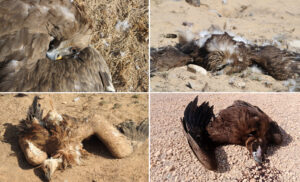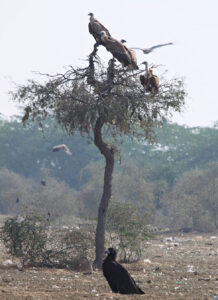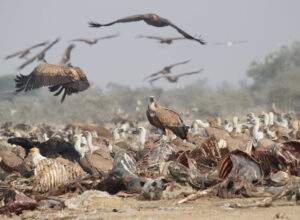Third International Scientific and Practical Conference “Eagles of the Palearctic: Study and Conservation”
Raptors Conservation. Suppl. 2. Proceedings of Conferences
Raptors Mortality in Northwest Rajasthan, India (2017–2022)
Bohra D.L. (Department of Zoology, Seth G.B. Podar College, Nawalgarh, Jhunjhunu, Rajasthan, India)
Rao M.S. (Department of Zoology, Government Science College, Sikar, Rajasthan, India)
Contact:
Dau Lal Bohra daulalbohara@yahoo.com
Maha Singh Rao msingh4209@gmail.com
Recommended citation: Bohra D.L., Rao M.S. Mortality in Northwest Rajasthan, India (2017–2022). – Raptors Conservation. 2023. S2: 172–174. DOI: 10.19074/1814-8654-2023-2-172-174 URL: http://rrrcn.ru/en/archives/34999
A major contributing factor in declining populations of vultures is believed to be the widespread use of drugs such as Diclofenac, once commonly-used as a livestock anti-inflammatory drug. Use of Diclofenac is now banned in India. However, during the last 3 years, vulture’s death cases are increasing not only in Rajasthan but also in other parts of India. From 2017–2022, a total of 791 vultures of 3 species i.e. Eurasian Griffon Vulture (Gyps fulvus), Cinereous Black Vulture (Aegypius monachus), and Egyptian Vulture (Neophron percnopterus), and 231 Steppe Eagle (Aquila nipalensis) were found dead at Jorbeer dumping site.
Jorbeer has been declared as conserved forest area, but dead livestock dumping site is not part of the protected area. The dramatic vulture decline observed across India leads to the emergence of a range of new ecological threats by influencing the numbers and distribution of other scavenging species. Increased feral dog populations have been reported all over in India, posing many associated disease risks, such as rabies, to humans and wildlife. India already has a very high incidence of rabies, and a severe shortage of quality rabies vaccine in rural areas could further aggravate the problem. Similarly, increased crow populations at carcass dumps in vicinity of settlements pose a risk of infections to poultry, domesticated birds, avian & humans.
The situation has improved slightly after the ban on diclofenac (veterinary and human use) in India since 2015, but other drugs used to treat livestock continue to kill migratory raptors and vultures in northern India. The main drugs involved into this are Ketoprofen and Phenylbutazone. The existence of only a small proportion (<0.8%) of ungulate carcasses containing lethal levels of such drugs is sufficient to cause a rapid decline in vulture populations.
Strategic planning is needed to protect migratory vultures and eagles from Russia, Kazakhstan and Central Asian countries. While the number of vultures is declining day by day, the death toll in Rajasthan is a major part of the world percentage.



